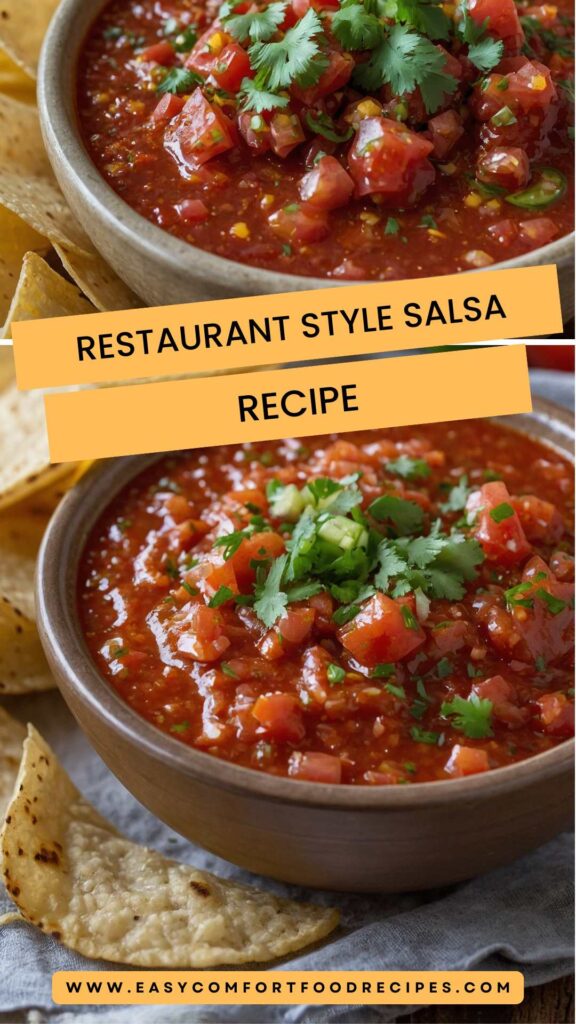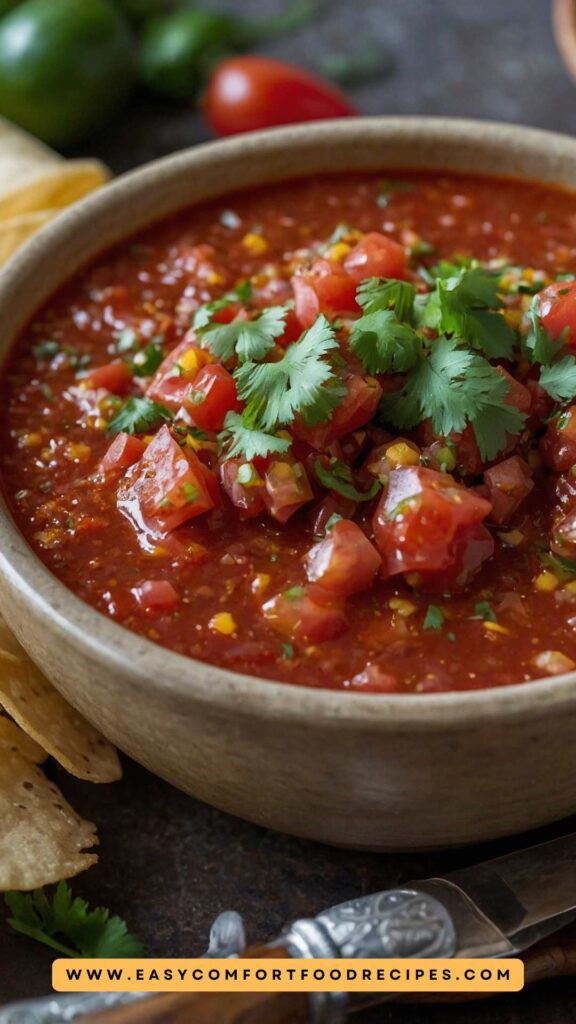Salsa not only adds vibrancy to meals but also enhances flavors in countless dishes. Pair this salsa with crispy tortilla chips for an irresistible appetizer. It also shines on top of grilled chicken or fish, bringing freshness to any protein.
Tacos become a fiesta with salsa drizzled over them, while burritos and quesadillas are brought to new heights. And let’s not forget about nachos—a generous layer of salsa can transform simple toppings into extraordinary bites.

Have you ever tasted that delightful salsa at your favorite restaurant? You know, the one that makes your taste buds dance?
That fresh, zesty, and slightly spicy concoction has a way of elevating any meal. Making restaurant-style salsa at home is not only possible but also incredibly rewarding.
I’ll guide you through creating your very own batch, ensuring you capture that restaurant-quality flavor right in your kitchen. You won’t want to go back to store-bought once you’ve tried this!
You Might Also Like These Recipes!
- Hot Apple Pie Salsa
- Spicy Brown Sugar Bacon Wrapped Little Smokies
- Ultimate Instant Pot Beef Barbacoa
What is Restaurant Style Salsa?
Restaurant-style salsa is typically a fresh tomato-based condiment that balances sweetness, acidity, and a kick of heat. It often relies on quality ingredients like fresh tomatoes, aromatic onions, and zesty lime.
This salsa is chunkier than its milder counterparts and is perfect for adding texture to various dishes. The beauty lies in its simplicity; with just a few fresh ingredients and a quick blend, you can achieve a flavor that rivals any restaurant.
What is the Flavor Profile of This Dish?
The flavor profile of restaurant-style salsa is vibrant and bold. You’ll first experience the taste of ripe tomatoes, which offer a natural sweetness. The onions contribute a sharp yet pleasant bite, complemented by the fragrant notes of garlic.
A squeeze of lime juice adds a refreshing acidity, making the salsa lively rather than flat.
Finally, the addition of jalapeño or other peppers provides warmth, balancing the sweetness from the tomatoes and the tanginess from the lime. This blend creates a flavor explosion that pairs well with various dishes.
What Makes This Recipe Different From Other Restaurant Style Salsa?
What sets this recipe apart is its focus on freshness and balance. Many commercial salsas tend to rely on additives or preservatives. On the other hand, my homemade version ensures that every ingredient shines in its pure form.
There’s no overpowering vinegar flavor—just fresh ingredients working harmoniously to bring you that restaurant experience.
By adding a touch of sugar and a squeeze of lime, we elevate the flavor profile and enhance the richness of the tomatoes. Plus, the recipe is customizable to suit your spice preference!
Ingredients You’ll Need
To make this salsa, you will need the following ingredients:
- 1 jalapeño pepper, deseeded and chopped
- 1 teaspoon granulated sugar
- 1 tablespoon extra virgin olive oil
- 1/2 medium red or white onion, coarsely chopped
- Juice of 1 fresh lime
- 1/2 teaspoon ground cumin
- 1 small bunch of fresh cilantro leaves, chopped
- 28 oz can of whole peeled tomatoes, with juices
- 2 cloves of garlic, smashed and chopped
- 1 teaspoon fine sea salt
Step by Step Directions
Step 1: Prepare Your Ingredients
Start by gathering all your ingredients. Wash the jalapeño pepper, cilantro, and any other fresh ingredients. For this salsa, freshness is key. Chop the onion and cilantro, smash the garlic, and set aside.
Step 2: Blend the Base
In a large mixing bowl, combine the can of whole peeled tomatoes (including the juices) with the chopped onion, garlic, and jalapeño. Using a fork or a hand masher, mash the mixture gently until combined. It’s okay to leave some chunks; remember, we want that authentic texture.
Step 3: Add the Flavor Boosters
Now, it’s time to bring in the flavors! Add in the lime juice, extra virgin olive oil, granulated sugar, ground cumin, and fine sea salt. Stir the mixture to evenly distribute all the flavors. This step is crucial, as it allows each ingredient to shine through.
Step 4: Incorporate the Cilantro
Fold in the chopped cilantro. This herb not only adds flavor but also a beautiful green freshness to the salsa. It’s best to mix it in gently to avoid bruising the cilantro leaves.
Step 5: Taste and Adjust
Give your salsa a taste. Adjust the seasoning as necessary by adding more salt, lime juice, or even more jalapeño if you like it spicier. Remember, flavor develops over time, so a bit of patience is key to achieving your preferred taste.
Step 6: Chill and Serve
It’s best to let the salsa chill in the refrigerator for at least an hour before serving. This time allows the flavors to meld together beautifully. When you’re ready to serve, give it another quick stir, and it’s ready to go!

Tips On Making Restaurant Style Salsa
Creating the perfect salsa at home is easy with these handy tips:
- Use Fresh Ingredients: Fresh tomatoes and herbs make all the difference. If you can, select high-quality tomatoes for richer flavor.
- Adjust Spice Levels: If you prefer a milder salsa, you can reduce or omit the jalapeño pepper. Conversely, you can incorporate a spicier pepper for more heat.
- Macerate the Onions: For a milder onion flavor, soak chopped onions in cold water for about 10 minutes before use. It takes the edges off their bite.
- Experiment with Add-Ins: Don’t hesitate to add other ingredients like corn, black beans, or even mango for a twist.
- Store Properly: Ensure your salsa is in an airtight container in the refrigerator. This keeps it fresh longer.
Nutrition Information
Restaurant Style Salsa Recipe Nutrition Facts

How Can I Store This Restaurant Style Salsa?
Once you have prepared your salsa, storing it properly ensures you can enjoy it for days. Transfer the salsa to an airtight container and refrigerate it.
It should remain fresh for about 5 days. For longer storage, consider freezing it in portion-sized containers, where it can last for up to three months. Just remember to defrost it in the refrigerator when you’re ready to enjoy.
Substitute Options for Ingredients
If you find yourself missing some ingredients, don’t fret! Here are some versatile substitutions:
- Canned Tomatoes: If you don’t have canned tomatoes, fresh tomatoes can work. Just chop and use a few extra for the same volume. Opt for varieties like Roma or vine-ripened for the best flavor.
- Jalapeño Pepper: For a different spice level, use serrano pepper for more heat, or bell pepper for no heat at all.
- Cilantro: If you’re not a fan of cilantro, exchange it for fresh parsley or basil. These herbs will provide a different yet delicious profile.
- Granulated Sugar: To keep it natural, try using honey or agave syrup in place of granulated sugar. This provides a subtle sweetness that complements the ingredients beautifully.
Conclusion
Making restaurant-style salsa at home isn’t just simple; it’s an enjoyable experience that rewards you with a delicious result. You control the ingredients, flavors, and spice levels while impressing your friends and family.
Whether you eat it with chips or use it as a condiment, this salsa will deliver joy in every bite. So roll up your sleeves, gather your ingredients, and let’s kick your salsa game up a notch!
You Might Also Like These Latest Recipes!

Restaurant Style Salsa Recipe – Easy Comfort Food Recipes
Description
Have you ever tasted that delightful salsa at your favorite restaurant? You know, the one that makes your taste buds dance?
That fresh, zesty, and slightly spicy concoction has a way of elevating any meal. Making restaurant-style salsa at home is not only possible but also incredibly rewarding.
Ingredients
Instructions
Step 1: Prepare Your Ingredients
-
Start by gathering all your ingredients. Wash the jalapeño pepper, cilantro, and any other fresh ingredients. For this salsa, freshness is key. Chop the onion and cilantro, smash the garlic, and set aside.
Step 2: Blend the Base
-
In a large mixing bowl, combine the can of whole peeled tomatoes (including the juices) with the chopped onion, garlic, and jalapeño. Using a fork or a hand masher, mash the mixture gently until combined. It's okay to leave some chunks; remember, we want that authentic texture.
Step 3: Add the Flavor Boosters
-
Now, it’s time to bring in the flavors! Add in the lime juice, extra virgin olive oil, granulated sugar, ground cumin, and fine sea salt. Stir the mixture to evenly distribute all the flavors. This step is crucial, as it allows each ingredient to shine through.
Step 4: Incorporate the Cilantro
-
Fold in the chopped cilantro. This herb not only adds flavor but also a beautiful green freshness to the salsa. It’s best to mix it in gently to avoid bruising the cilantro leaves.
Step 5: Taste and Adjust
-
Give your salsa a taste. Adjust the seasoning as necessary by adding more salt, lime juice, or even more jalapeño if you like it spicier. Remember, flavor develops over time, so a bit of patience is key to achieving your preferred taste.
Step 6: Chill and Serve
-
It’s best to let the salsa chill in the refrigerator for at least an hour before serving. This time allows the flavors to meld together beautifully. When you’re ready to serve, give it another quick stir, and it’s ready to go!
Nutrition Facts
Servings 12
- Amount Per Serving
- Calories 15kcal
- % Daily Value *
- Total Fat 0.7g2%
- Saturated Fat 0.1g1%
- Sodium 280mg12%
- Total Carbohydrate 2g1%
- Dietary Fiber 1g4%
- Sugars 2g
- Protein 1g2%
* Percent Daily Values are based on a 2,000 calorie diet. Your daily value may be higher or lower depending on your calorie needs.
Note
Creating the perfect salsa at home is easy with these handy tips:
- Use Fresh Ingredients: Fresh tomatoes and herbs make all the difference. If you can, select high-quality tomatoes for richer flavor.
- Adjust Spice Levels: If you prefer a milder salsa, you can reduce or omit the jalapeño pepper. Conversely, you can incorporate a spicier pepper for more heat.
- Macerate the Onions: For a milder onion flavor, soak chopped onions in cold water for about 10 minutes before use. It takes the edges off their bite.
- Experiment with Add-Ins: Don’t hesitate to add other ingredients like corn, black beans, or even mango for a twist.
Store Properly: Ensure your salsa is in an airtight container in the refrigerator. This keeps it fresh longer.


